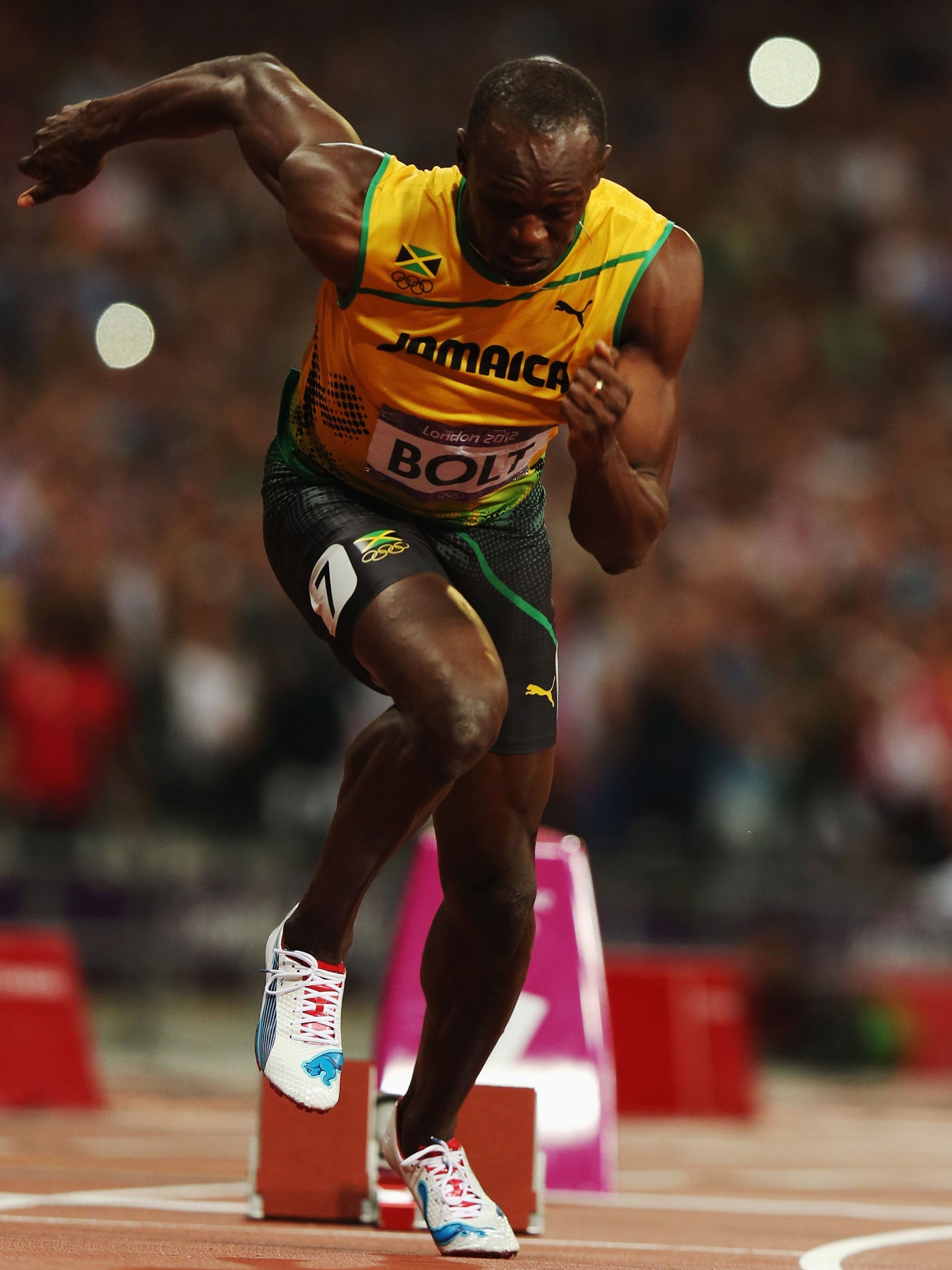Revealed: The science behind Usain Bolt power burst used to the 100m world record
Scientists work out the secrets behind the world’s fastest sprinter’s amazing time

It has taken just a little longer than the 9.58 seconds it took Usain Bolt to break the 100m world record, but scientists have finally worked out how much power the Jamaican needed to take gold at the athletics World Championships four years ago.
Bolt’s time in Berlin has yet to be beaten and any athlete who wants to do so will have to have a power output on the track of almost twice a Tour de France cyclist in the closing stages of a sprint.
At 6ft 5in, the fastest man on Earth is far from aerodynamic, and researchers in Mexico were astounded at the amount of energy Bolt has to exert to overcome the air resistance exacerbated by his frame.
They calculated he had a maximum power of 2619.5 watts after only 0.89 seconds of the race, when he was at half of his maximum speed, demonstrating the almost instant effect of the drag he has to fight against.
Measured in watts, power output during exercise is the one of the best measures of athletic performance. Tour de France cyclists run at about 500 watts for hours and can hit output of 1500 watts in short bursts.
According to the model, Bolt’s time of 9.58 seconds was achieved by reaching a terminal velocity of 12.2 metres per second, around a quarter of that achieved by a skydiver in a belly-to-earth freefall position, and exerting an average force of 815.8 newtons, close to the force of a knockout punch from a heavyweight boxer.
By taking into account the altitude of the Berlin track, the temperature at the time of the race and the cross-section of Bolt himself, researchers from the National Autonomous University of Mexico calculated that he had a drag coefficient of 1.2, which is less aerodynamic than the average human.
According to the calculations, Bolt exerted 81.58kJ of energy during the 9.58 seconds, but only 7.79 per cent of this was used to achieve motion; the remaining 92.21 per cent (75.22 kJ) was absorbed by the drag.
Co-author of the study, Jorge Hernandez, said: “Our calculated drag coefficient highlights the outstanding ability of Bolt. He has been able to break several records despite not being as aerodynamic as a human can be. The enormous amount of work that Bolt developed in 2009, and the amount that was absorbed by drag, is truly extraordinary.
“It is so hard to break records nowadays, even by hundredths of a second, as the runners must act very powerfully against a tremendous force which increases massively with each bit of additional speed they are able to develop.”
The calculations in the study, published in the European Journal of Physics today, were tested for accuracy by fitting real-life experimental data into the equations.
Data from the International Association of Athletics Federations’ (IAAF) laser velocity guard device recorded Bolt’s position and speed every one-tenth of a second during the 2009 race in Berlin.
“The accurate recording of Bolt’s position and speed during the race provided a splendid opportunity for us to study the effects of drag on a sprinter,” said Mr Hernandez.
Britons will get the chance to see the Jamaican in London again tonight at the Anniversary Games in Queen Elizabeth Olympic Park.
Bolt will compete against Britons James Dasaolu and Dwain Chambers in an eight-man lineup where every starter has broken the 10-second barrier.
John Barrow, Professor of Mathematical Sciences at Cambridge University, last year carried out his own research on the athlete and claimed Bolt could slash another 0.13 of a second off his world record, if he improved his reaction time at the start and ran in the best wind conditions possible.
Failing that, it will take an out of this world performance to break the record, as Mr Hernandez added: “If Bolt were to run on a planet with a much less dense atmosphere, with fewer ‘physical barriers’ imposed by the conditions on Earth, he could achieve records of fantastic proportions.”
Power surge: How bolt compares with the best
Bolt 2691.5 watts v…
Steve Redgrave
Britain’s most successful Olympian hit a maximum of around 500 watts during his five gold medal victories at consecutive Games.
Mark Cavendish
The Manxman has won 25 Tour de France stages, a British record. In his trademark sprint finishes, Cavendish reaches 1500 watts as he reaches speeds in excess of 45mph.
Chris Hoy
A top track sprinter such as Hoy can get close to Bolt with a maximum output of around 2,200 watts for short bursts.
Michael Phelps
Based on calculations using his 12,000 calorie a day diet, the US swimmer has an output of more than 2,500 watts when breaking records in the pool.
Oleksiy Torokhtiy
The Ukrainian weightlifter won gold in London 2012 in the 105kg heavyweight category. His winning clean and jerk would have consisted of 2,200-plus watts for the first movement and an enormous 3,700-plus watts output for the second movement lifting three times his bodyweight above his head.
Subscribe to Independent Premium to bookmark this article
Want to bookmark your favourite articles and stories to read or reference later? Start your Independent Premium subscription today.

Join our commenting forum
Join thought-provoking conversations, follow other Independent readers and see their replies